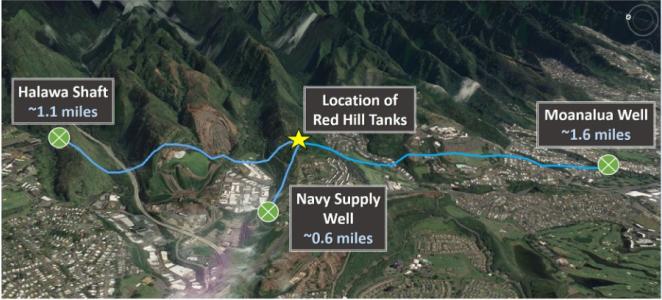 In December we posted Hawaii Deputy AG: Pearl Harbor Leaking Fuel Tanks a “Ticking Time Bomb” describing the fuel oil leaks in the massive World War II era fuel tanks into the island of Oahu’s water supply that forced over 1,000 military families from their homes.
In December we posted Hawaii Deputy AG: Pearl Harbor Leaking Fuel Tanks a “Ticking Time Bomb” describing the fuel oil leaks in the massive World War II era fuel tanks into the island of Oahu’s water supply that forced over 1,000 military families from their homes.
Last week, the results of two investigations were released describing a string of extraordinary failures in maintenance, training and leadership at the Navy’s Red Hill fuel facility that resulted in fuel spewing from a broken pipeline for 30 hours, leaking petroleum into the military’s drinking water and sickening entire families last year, military officials.
The Honolulu Civil Beat reports that human errors and systemic negligence allowed two catastrophic leaks to occur within months of each other.
The reports reveal that a leak on May 6 was much worse than initially reported – some 20,000 gallons escaped instead of the initially reported 1,000 – and that the failure to properly investigate that leak was a major factor in another one happening on Nov. 20. That second spill was the one that injected as many as 3,322 gallons of fuel into the drinking water, according to one of the reports.
“The BWS is disturbed but not surprised by the contents of the two documents released yesterday by the U.S. Navy regarding the Red Hill bulk fuel storage facility,” Honolulu Board of Water Supply Chief Engineer Ernie Lau said. “The Navy’s command investigation into the May and November 2021 fuel releases finally acknowledges that the tragic drinking water contamination occurred as a result of the Navy’s ineffective responses to these fuel releases.”
The Navy’s water system serves about 93,000 people at and near Pearl Harbor. The Red Hill water shaft, the site of the November contamination, is near the huge facility of 20 underground steel fuel tanks encased in concrete, each about 20 stories tall. The tanks were carved into the basalt rock after the Japanese attack on Pearl Harbor in 1941, following concerns that above-ground fuel depots would be targets for subsequent strikes.
Red Hill was constructed about 100 feet above Oahu’s sole drinking-water aquifer. Leaks and contamination issues have plagued the facility for years, culminating in a November spill that percolated into a well used by military families and civilians near the base.
The problems at Red Hill threaten more than the Navy water supply, given the aquifer’s role in serving the island of Oahu. The 76 spills since World War II resulted in leaks of nearly 200,000 gallons of fuel, which experts say is probably an undercount.
Video of one of the Red Hill leaks.

SNAFU